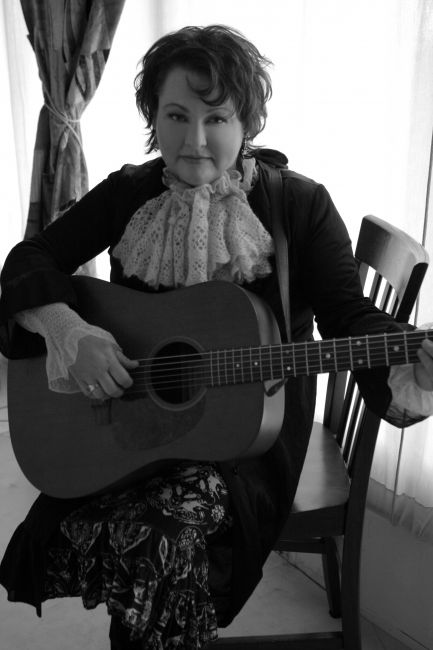Dale Ann Bradley: in search of a better place…Walking Distance
Dale Ann Bradley taps into an essential truth
By David McGee
SOMEWHERE SOUTH OF CRAZY
Dale Ann Bradley
Compass RecordsBreathes there a soul who has not wanted to break free from the old routine and find a place of restorative calm on a journey of reflection and reassessment? Rod Serling was on intimate terms with this phenomenon and wrote more than a couple of memorable, nay classic, Twilight Zone episodes centered on this very idea. Arguably the best of these is the 1959 drama titled “Walking Distance.” Starring Gig Young as harried white-collar Manhattanite Martin Sloan, the story recounts how Sloan, at wit’s end, bolts town one day, headed to anywhere but where he was. He gets away, way away--passing through a time warp that leads him back to his small town childhood, back to his childhood self playing on the carousel in the town square, then to visiting his parents when they were alive and vital, as they were in his youth.
The electronic press kit for Somewhere South of CrazyDale Ann Bradley’s new Alison Brown-produced Somewhere South of Crazy album is the great vocalist’s rootsy version of “Walking Distance,” not necessarily in the sense of returning to a simpler time but in finding a better place than the place you’re in, regardless of whether such a journey is spurred by Martin Sloan-like disaffection with the daily tedium, romantic upheaval or simple personal growth that should be, but is not always, part of living. Singing with heart tugging plaintiveness and measured, nuanced feeling, Bradley assays a collection of songs (some original, others from a range of writers representing several generations of roots music artists) in which the protagonists describe, in most cases, literal or metaphysical journeys of a transformative nature. For example, the brisk, bright “Next to Nothing” is Russell Dale Johnson’s uptempo discourse on the transformative experience of being dumped by a significant other (“I’m not the girl that I used to be/’cause you’re no longer here with me/I’m so alone/I’m next to nothing since you’re gone…”); Ms. Bradley sells it with a straightforward, cool approach designed to mask the searing ache of abandonment, as the lively solos by Matt Combs (fiddle), David Long (mandolin) and Mike Sumner (banjo) practically mock her distress. Joyce Reba Rambo’s sprightly gospel tune “New Shoes” finds the singer anticipating a new home in her next life, in Heaven (“I’ve made my reservation for my final destination…”), a matter of fact announcement Bradley makes with persuasive assertiveness as a wondrous all-star lineup brings the high-stepping arrangement home with a fine ensemble effort (the band includes Ms. Brown on banjo, Stuart Duncan on fiddle, Mike Bub on bass, Steve Gulley on harmony vocal and guitar, and Sierra Hull on mandolin--Gully is on every track and has some wonderful moments singing harmony with Bradley, and the really smart move here was to enlist the young Ms. Hull’s tasty, restrained mandolin support on eight of the 12 tracks, the 17-year-old phenom’s first extended appearance on record in a supporting role).
Dale Ann Bradley, ‘I Pressed Through the Crowd,’ a live version of the Joe Isaacs song from Somewhere South of CrazyThe supposed binding concept this reviewer detects stems from the title track, the album’s first song, perfectly positioned to suggest the connective tissue binding all else into a unified statement. Bluegrass with an extra tinge of blue, “Somewhere South of Crazy,” co-written with no less than Pam Tillis (who also pitches in with a lovely, silky harmony vocal on the choruses), struts purposely to its climax, with evocative solos from Ms. Hull, Ms. Brown and Mr. Duncan, as well as Andy Hall on dobro, dotting the singer’s easygoing but determined declaration of her intent to find a place “where the trade winds rock me like a baby,” where her troubles dissipate and the living is easy. This sets the restless mood conveyed in most of the other tunes. It’s not all about leaving--a cover of Seals and Crofts’ “Summer Breeze,” with Duncan’s fiddle and Hull’s mandolin adding evocative backwoods touches to the pop melody, is a step-by-step report of the singer’s return to a place abundant in some of the things--companionship, love faithful and true--she’s searching for in other songs; and Sarah Pirkle’s country ballad, “Come Home Good Boy,” despite being centered on a young man’s leaving to serve his country abroad, is really a moving prayer for the good boy’s safe return home as a good man, with Bradley and Hull melding their voices in sweet, affecting harmony on the choruses.
“To the one who’s been away too long/the steps are open arms/and they’ve always been a place where young lovers exchange hearts/they’re shelter from the rain…” Thus does Bradley sing in the live signoff number, Leslie Satcher’s “Old Southern Porches,” a poignant reminiscence of home, sweet home rendered in a stark guitar-and-vocal treatment made doubly powerful by its austere presentation. The home you cultivate in your heart and in your memory, and draw strength from thereafter--through “the mystery of strange million-visaged time that haunts us with the briefness of our days,” as Thomas Wolfe observed in Of Time and The River--is the place we belong. Martin Sloan learned this at the end of “Walking Distance,” and Dale Ann Bradley is perfectly attuned to its truth in Somewhere South of Crazy.
Dale Ann Bradley’s Somewhere South of Crazy is available at www.amazon.com
Founder/Publisher/Editor: David McGee
Contributing Editors: Billy Altman, Laura Fissinger, Christopher Hill, Derk Richardson
Logo Design: John Mendelsohn (www.johnmendelsohn.com)
Website Design: Kieran McGee (www.kieranmcgee.com)
Staff Photographers: Audrey Harrod (Louisville, KY; www.flickr.com/audreyharrod), Alicia Zappier (New York)
E-mail: thebluegrassspecial@gmail.com
Mailing Address: David McGee, 201 W. 85 St.—5B, New York, NY 10024



